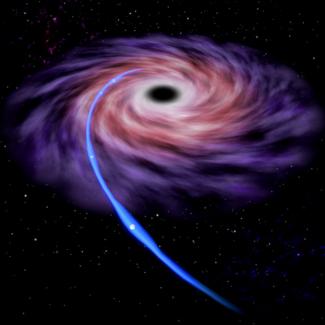When an ordinary star like our Sun wanders very close to a supermassive black hole, it’s very bad news for the star. The immense gravitational pull of the black hole (i.e., tidal forces) overcomes the forces of gravity holding the star together and literally pulls the star apart. Over time, the black hole swallows half of the star stuff, while the other half escapes into the interstellar medium. This destructive encounter between a supermassive black hole and a star is known as a tidal disruption event.
The idea of doing a detailed simulation of a tidal disruption event recently captured the imaginations of graduate student Eric Coughlin and research associate Chris Nixon (Begelman group). Others had done this kind of work, but either with such low resolution that it wasn’t possible to see what was happening in the star or with unphysical parameters, such as modeling a supermassive black hole as having the mass of 1,000 suns when realistically it would have a mass of around 1,000,000 suns.
“We wanted to see exactly what happens if you have a star that’s wandering around and finds itself on a path that’s going to bring it very close to a supermassive black hole like the one at the center of our Galaxy,” Coughlin said, adding that he and Nixon wanted to see what was happening to all the parts of the star during a tidal-disruption process. To do this, the researchers had to create a realistic simulation that used as many real physical parameters as possible. They also had to make sure their wandering star didn’t get close enough to their simulated supermassive giant black hole to be swallowed whole.
Coughlin and Nixon's simulation followed the tidal disruption encounter for the equivalent of 10 years. They already knew tidal disruption was a gradual process, and they wanted to learn more about how a spherical star gets turned into a stream of star stuff rather like a strand of cooked spaghetti.
“What we found was really surprising,” Coughlin said. “About a month after the disruption, portions of the stream started to fragment. It sort of broke up into individual fragments all along it and formed localized gravitationally bound clumps.”
In other words, meatball-like globs of star stuff appeared inside (rather than on top of) the "spaghetti" strand formed by the tidal disruption. The self-gravity of the stream (left over from the star’s self-gravity) was creating these “meatballs.” Inside the stream, the star particles were both attracted to each other as well as to the black hole that was pulling the whole stream into it. The discovery of the lumps of star stuff has complicated things considerably.
Intriguingly, about an hour after the star's disruption in the simulation, the researchers observed the front and back of the star start to compress and attempt to switch places. This squeezing, caused by the gravitational field of the black hole, increases the stellar stream's self-gravity and causes the stream to fragment—cooking the meatballs for the black hole to eat. This weird result led the researchers to perform more complex simulations (in collaboration with Fellows Mitch Begelman and Phil Armitage) to test whether the compression is real or just an artifact of the original simulation. Early results suggest there’s something really interesting happening. Stay tuned.—Julie Phillips




